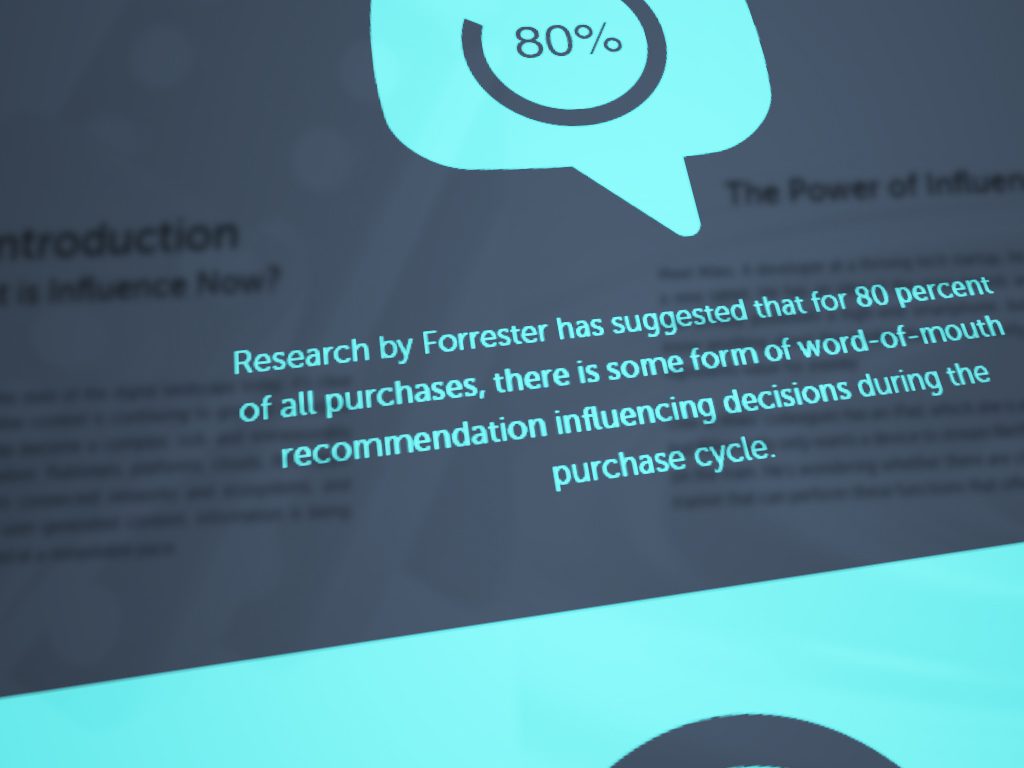Consumers expect and demand genuine product feedback prior to purchase. That’s why it’s more important than ever for brands to work with influencers, who have the ability to communicate said feedback to consumers in palatable ways. This also means influencers have more power and are no longer waiting around to be discovered, but rather joining marketplaces that brands are using to connect with them. Going forward, it won’t be enough for brands to simply find influencers, but they’ll have to actually align said influencers with the ROI of their brands. Here’s a closer look at how influencer marketing has changed over the years and what specifically is to come in 2015.
As the final season of “Mad Men” approaches in April to pay homage to an extinct advertising world, real-life brands and marketers are confronting a much different reality in 2015.
In the “Mad Men” advertising era, the Don Drapers of the industry were themselves influencers who held sway over ads that told consumers what to buy. But today’s consumers have much more power.
“For years, marketers knew and had insight about how to engage and influence behavior,” said Holly Hamann, CMO of influencer marketing platform Tapinfluence. “Look at TV, radio and print advertising. Marketers knew more about those channels than consumers did, which gave them leverage. Within the last few years, however, with [the rise of] social…consumers know more about these channels than marketers do.”
What’s more, these channels are where consumers are having conversations, doing research, and making purchasing decisions. That’s because they are getting opinions from peers and other experts on products before they buy anything. And these peer/expert opinions have become increasingly important.
That also means marketers – who may very well be part of an older generation, albeit perhaps not quite as old as Draper’s – have to now try to keep pace on platforms they didn’t necessarily grow up with and for whom “social media is a conscious effort, not a born organic effort,” Hamann said.
From Big Audiences To Authentic Audiences
With the rise of content marketing, which has more or less created an insatiable appetite for stories and images, as well as for the pace and volume at which they appear, more traditional forms of digital advertising like banner ads are seeing declining influence on purchase decisions, Hamann said. And that really creates an opportunity for influencers.
But not just any influencers – influencer marketing has seen a definite shift from simply the social media powerhouses with the most fans/followers to the ones with the best fans/followers for a given brand. Or, as Eric Brown, vice president of communications at social network engagement company Lithium Technologies, which acquired online expertise management firm Klout last year, puts it, there has been a shift from big audiences to authentic audiences.
“The early era of influencer marketing was all about ‘How can we activate the most people?’” Brown said. He noted that’s a holdover from display advertising days in which online properties asked brands how many people they wanted to reach and how much money they had to spend.
“But in influencer marketing, it’s not about buying audiences in bulk. It’s about finding authentic ways to talk to people who are already engaged in your products and services and tapping them,” Brown said.
These campaigns reach smaller audiences, but the consumers they do reach are active, interested and can help get the word out further and do better things for a brand, Brown said. He uses the example of the gaming community in which traditional advertising can help communicate a new game, but influential gamers are the ones that tell consumers whether the game is actually engaging and fun to play.
“Call of Duty”, for example, created a campaign with Lithium in which about 2,000 people participated, but it generated 140 million impressions and had a total audience reach of 33.3 million, which Brown said is “the beauty of influencer marketing.”
This is a shift that could also benefit smaller agencies.
A lot of advertising is sold through big agencies, Brown said, but it is harder for them to create meaningful revenue models around influencer marketing.
“It would be really hard for one of the big advertising/marketing conglomerates to create a revenue stream that would be really meaningful for them to target 2,000 people,” Brown said. “But for in-house marketers or a smaller creative agency that wants to bring innovative thinking and fresh approaches, they will say that for the good of the client, they will integrate influencer marketing into a campaign.”
The Rise Of Influencer-Brand Partnerships
Influencer marketing has also seen a shift in content and an increased desire from brands to forge partnerships.
A few years ago, influencer marketing was all about blogs. Consumer brands targeted women – even if they weren’t a given product’s end user – because they do most of a given household’s shopping and make up a big chunk of the blogging community.
Then came YouTube and there was an even bigger explosion of video content with millions of channels from so-called Haulers, who post videos detailing recent shopping sprees, and Sneakerheads, which, as the name implies, post videos about sneakers. And with the products reviewed in these videos came opportunities for brands and a subsequent “explosion in terms of brands wanting to partner with video influencers,” Hamann said. That’s particularly true in industries that are more visual, like fashion, food, and fitness.
This has also led to the rise of networks like StyleHaul, a fashion and beauty network on YouTube that represents Haulers because brands are trying to reach them and work with them, Hamann said. According to StyleHaul, it has 17 billion network video views, nearly 200 million network subscribers and 4,900 network channels. Coincidentally, in November, entertainment company RTL Group acquired a controlling stake in StyleHaul for $107 million, valuing the company at $151.4 million.
Increased video content has also seen a rise of a subgenre of Vine influencers, which, in turn, has led to some cross-platform trends, she notes.
As brands like McDonald’s, Taco Bell, and Silk have embraced Vine, this subgenre of Vine influencers called “Vine magicians” that can do “neat editing tricks” have emerged, Hamann said. The best example of a brand harnessing this subgenre is HP, which did a TV commercial with nothing but Vines from influential Viners. The resulting #BendtheRules spot has more than 3.6 million views to date.
https://www.youtube.com/watch?v=B9Tx6olI3l8The HP spot also marks crossover between a social platform and a traditional means of advertising. Another example is brands like McDonald’s and Taco Bell using Snapchat. The scarcity of such images inspires young consumers to capture them and post them to other channels like Instagram and Pinterest, Hamann said.
Keeping It Authentic: Citizens, Not Celebrities
This shift in content and the rise in popularity of regular Joes and Janes underscores one important shift in customer expectations: Consumers want more authority from influencers. Brown calls this the shift from celebrity to citizen.
Celebrities still clearly work in traditional advertising, “but we’ve found celebrities are not very credible in influencer marketing and engaging people online. That’s where citizens come in,” Brown said.
In other words, a mother of a toddler is a more credible source of information about diapers and daycare services than, say, actress Nicole Kidman. He also points to ads he has seen on San Francisco public transit for a renter’s insurance company that is using actor/host Mario Lopez, who, again, is perhaps not the most reliable authority on renter’s insurance. Instead, consumers want credible feedback from sources that they can use to make informed decisions.
“I think the reaction is more amplified in a digital world where people are all about keeping it real and making it authentic and making it deeply personal for me,” Brown said.
Even if the celebrity culture is alive and well in many respects – look no further than the Kardashians – consumers have come to expect more personal and deeply relevant experiences thanks in part to content sharing on networks like Facebook, Twitter, Pinterest, etc., where images and posts are often personal and deeply relevant.
Plus, Millennials simply have more distrust for traditional models like TV advertising.
“I’m smart enough to know that they’re going to tell me what I want to hear,” said Katie Paterson, digital marketing director for influencer marketing platform Traackr. And even with the rise of content marketing and content in Google ads or in display ads on Spotify and Pandora, content is still being pushed toward buyers in ways that do not resonate, she said.
“Where 2015 and beyond goes is the rise of the influencer in which brands take their content marketing strategies and put content in the hands of people who are actually trusted by the buyer,” Paterson said.
That means more brand-influencer partnerships to come. And more paid media to support that influencer content.
No longer does influencer marketing mean finding popular bloggers, sending them free products and hoping they will mention them, said Marcy Massura, senior vice president and digital practice lead at PR firm MSLGroup. Instead, she expects to see “much more play” in the paid content creator category in 2015 in which brands partner with influencers and “have them create the kind of content that will resonate with their audience first, but also benefit the brand second. That really is the magic sweet spot,” she added.
For years, brands have been paying for their content to be seen, she said.
“They do YouTube pre-roll in which they are paying to say, ‘Look at what we made,’” Massura said. “But encouraging and developing programs for brands to use paid dollars to support influencers’ content and generating great results and great scale reaches a broader range of people.”
More Big Data, Tools & Technology
New technology and tools in the works will allow brands to not just identify the right influencers, but to create metrics to align with their business objectives.
“What 2015 to 2016 will be about is not just finding influencers, but about aligning them to the ROI of your business,” said Katie Paterson, digital marketing director for influencer marketing platform Traackr.
Big data has given brands new tools to find people with specific interests, influence and resonance within tiny audience segments. For its part, Klout scores online profiles and tracks engagement, resonance and relevance over 10,000+ topics. This allows brands to very specifically target influencers with a range of characteristics like, say, a 35-year-old mother of two who lives in Los Angeles and is passionate about healthy fast food, Brown said.
“Big data is playing a very big role in how influencer marketing is changing,” Brown said.
Hamann agreed that in the next few years, the market will see more tools and technology, bringing efficiencies on the platform side and allowing influencers to manage content and payments.
“It’s just like email marketing – once they figured out how to do it, you start to see tools that pop up that allow them to do it right and scale it and influencer marketing is scaled to do well and be more rapidly adopted,” Hamann said.
This also includes the rise of influencer portals, which Massura said are really going to take off in 2015.
“We do some of that, but influencer marketing at scale has been the biggest challenge for agencies and it is solved by web-based portals, which help manage large numbers of influencers,” she said.
What changes do you expect to see in the influencer marketing space in 2015?



